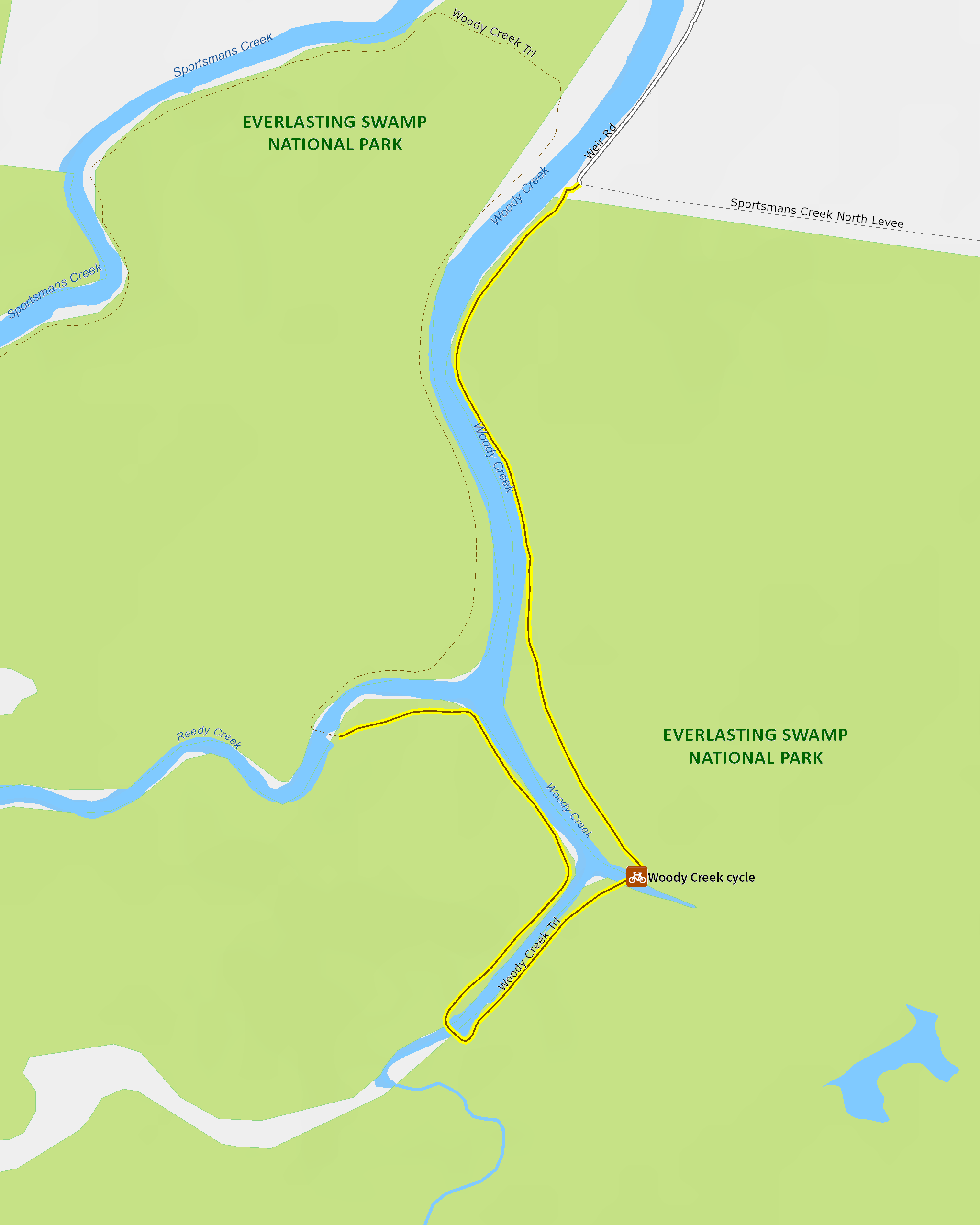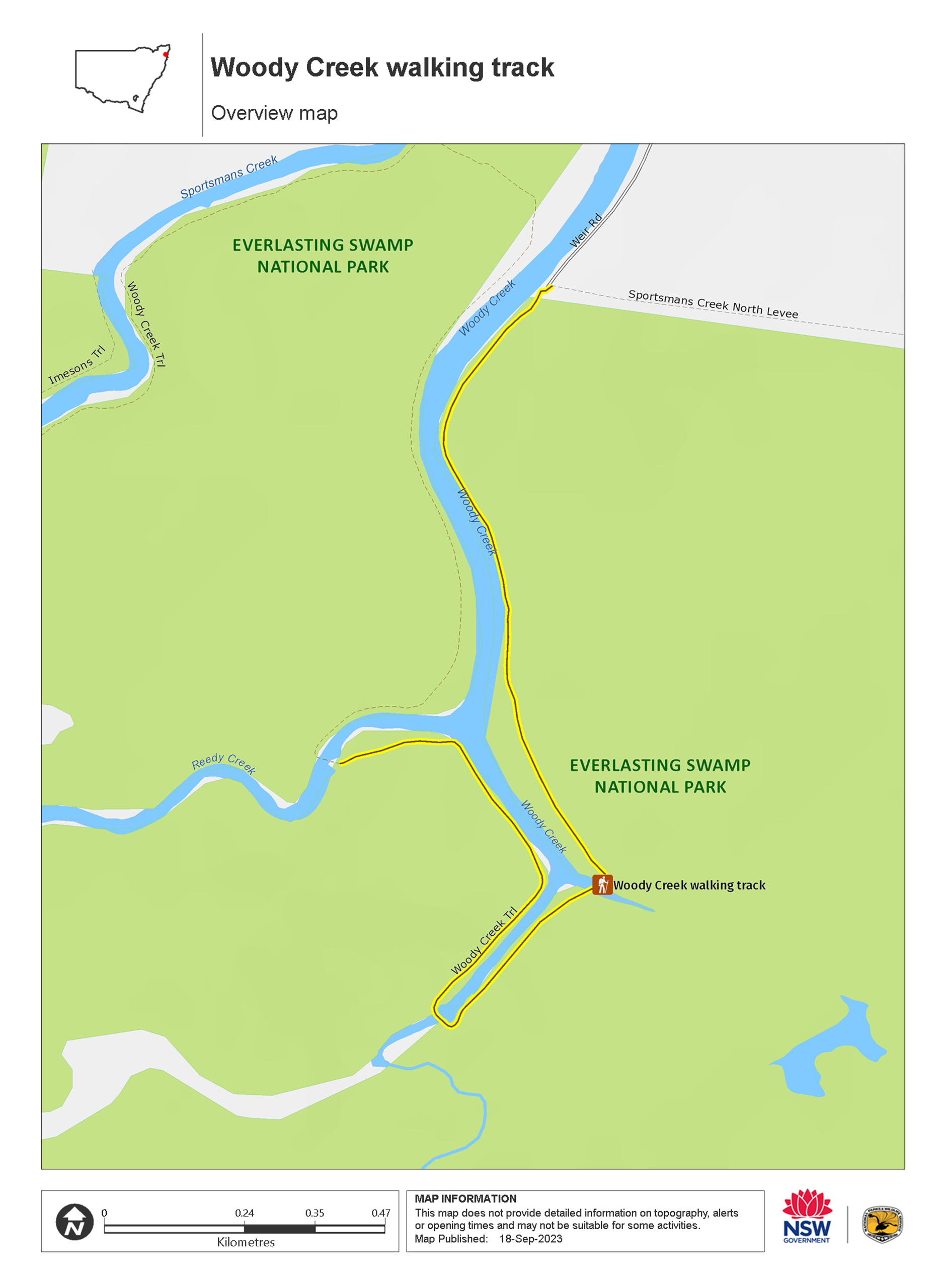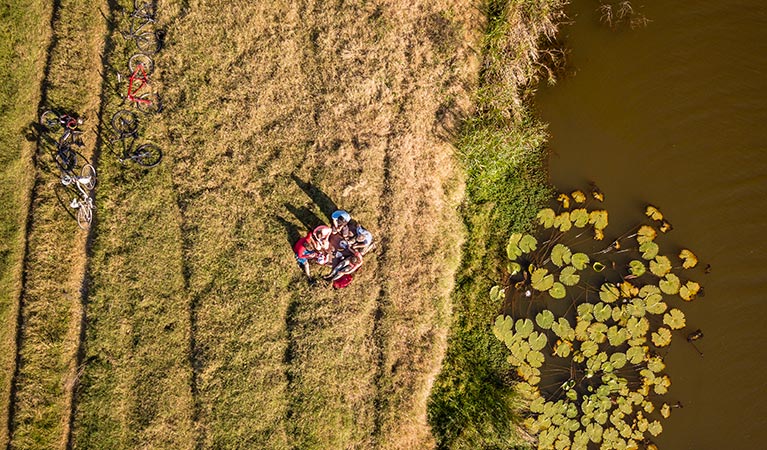Woody Creek walking track
Everlasting Swamp National Park
Overview
Take a tranquil walk into the heart of Everlasting Swamp on this easy, family-friendly walking track near Grafton. This shimmering wetland in the Clarence Valley is a top spot for birdwatching.
- Accessibility
- No wheelchair access
- Distance
- 5km return
- Time suggested
- 1hr
- Grade
- Easy
- What to
bring - Drinking water, first aid kit, sunscreen, hat, snacks, sturdy shoes, suitable clothing, raincoat
- Please note
- Avoid cycling in Everlasting Swamp National Park after rainfall or flooding
- Cool, late autumn and winter days are the best times to use this walking track.
- Snakes are common in this park, so take care when walking or cycling through long grass.
This 2hr walk is the perfect way to experience the vibrant birdlife that take refuge in this rare coastal wetland. Bring the kids and head to a fishing spot to cast a line when bass are in season from September to April. Or, settle into a picnic on the tree-lined banks of Woody Creek.
Arrive at the park and trail head for a 5km return-walk along Weir Road, or drive along Weir Road into the park until you reach the gravel parking lot next to the park entry sign.
From the parking lot you’ll hike south along Woody Creek on the flat management trail.
Keep an eye out for tall, elegant brolgas, especially in August when you might be lucky enough to see their courtship dances.
After about 1.5km the trail crosses a branch of Woody Creek. Continue for another 200m, cross another branch of the creek over a small bridge, then walk for 1km along the other side of Woody Creek.
The track ends just past Woody Creek’s junction with Reedy Creek. Before turning back, linger for a while to watch wedge-tailed eagles circle overhead. Turn back to walk the way you came.
Map

Map legend

Map

Local alerts
For the latest updates on fires, closures and other alerts in this area, see https://www.nationalparks.nsw.gov.au/things-to-do/walking-tracks/woody-creek-walking-track/local-alerts
General enquiries
- National Parks Contact Centre
- 7am to 7pm daily
- 1300 072 757 (13000 PARKS) for the cost of a local call within Australia excluding mobiles
- parks.info@environment.nsw.gov.au
Park info
- in Everlasting Swamp National Park in the North Coast region
Everlasting Swamp National Park is open all year, but may have to close at times due to weather conditions or fire danger.
Visitor info
All the practical information you need to know about Woody Creek walking track.
Maps and downloads
Learn more
Woody Creek walking track is in Everlasting Swamp National Park. Here are just some of the reasons why this park is special:
All about the birds

Birds are the real drawcard at Everlasting Swamp. After flooding rainfall this wetland really goes into overdrive. Wading birds are drawn to the park and large flocks of migratory birds pass through. Watch pelicans land like sea planes or look up in trees for huge stick nests of endangered black-necked storks—Australia’s only stork. Come to spot other birds including teals, swamp harriers, black swans and white-bellied sea eagles. With some of the largest flocks of vulnerable brolga in NSW, you may see up to 70 of these majestic cranes bob, bow and strut in courtship.
- Woody Creek walking track Take a tranquil walk into the heart of Everlasting Swamp on this easy, family-friendly walking track near Grafton. This shimmering wetland in the Clarence Valley is a top spot for birdwatching.
Wild wetland refuge

Bursting with life, Everlasting Swamp National Park is named for the large number of waterfowl living in the backswamp next to Clarence River. Sportsmans Creek meanders through the wetland’s heart, then into Clarence River. Its banks are shaded by swamp oak, gum and paperbark trees. Beyond these raised creekbanks you’ll see lower-lying sedgeland of grasses, rushes and endangered reeds—a haven for wading birds. When summer rains flood the area, the creekbanks work like sides of a giant bathtub, holding water in the wetland then slowly letting it drain.
- Woody Creek walking track Take a tranquil walk into the heart of Everlasting Swamp on this easy, family-friendly walking track near Grafton. This shimmering wetland in the Clarence Valley is a top spot for birdwatching.
A history of hunting and farming

Vast, forested and always wet, Everlasting Swamp was so-named in the 1800s by European Australians who came for easy game. In Sportsmans Creek they caught huge fish and shot birds in disturbingly large numbers. From 1910, landholders worked to tame the wetland’s extremes. They cleared forest, built weirs to prevent natural inflows of salty water at high tide and built drains to turn the swamp into pasture land. Part of Everlasting Swamp’s heritage, you can still see some of these structures today.
Plants and animals protected in this park
Animals
-

Eastern snake-necked turtle (Chelodina longicollis)
Found across most of NSW, the eastern snake-necked turtle, also known as the eastern long-necked turtle, can be found in swamps, lakes and inland waterways. This freshwater turtle is carnivorous and lives most of its life submerged on the water’s edge, searching for worms and snails.
-

Eastern water dragon (Intellagama lesueurii lesueurii)
The eastern water dragon is a subaquatic lizard found in healthy waterways along eastern NSW, from Nowra to halfway up the Cape York Pensinsula. It’s believed to be one of the oldest of Australian reptiles, remaining virtually unchanged for over 20 million years.
-

Brown-striped frog (Lymnastes peronii)
One of the most common frogs found in Australia, the ground-dwelling brown-striped frog lives in ponds, dams and swamps along the east coast. Also known as the striped marsh frog, this amphibian grows to 6.5cm across and has a distinctive ‘tok’ call that can be heard all year round.
-

Swamp wallaby (Wallabia bicolor)
The swamp wallaby, also known as the black wallaby or black pademelon, lives in the dense understorey of rainforests, woodlands and dry sclerophyll forest along eastern Australia. This unique Australian macropod has a dark black-grey coat with a distinctive light-coloured cheek stripe.
-

Tawny frogmouth (Podargus strigoides)
Found throughout Australia, the tawny frogmouth is often mistaken for an owl due to its wide, powerful beak, large head and nocturnal hunting habits. The ‘oom oom oom’ call of this native bird can be heard echoing throughout a range of habitats including heath, woodlands and urban areas.
-

Wedge-tailed eagle (Aquila audax)
With a wingspan of up to 2.5m, the wedge-tailed eagle is Australia’s largest bird of prey. These Australian animals are found in woodlands across NSW, and have the ability to soar to heights of over 2km. If you’re bird watching, look out for the distinctive diamond-shaped tail of the eagle.
-

White-bellied sea eagle (Haliaeetus leucogaster)
White-bellied sea eagles can be easily identified by their white tail and dark grey wings. These raptors are often spotted cruising the coastal breezes throughout Australia, and make for some scenic bird watching. Powerful Australian birds of prey, they are known to mate for life, and return each year to the same nest to breed.
Plants
-

Grey mangrove (Avicennia marina)
Grey mangrove is the most common and widespread mangrove found within intertidal zones across Australia, and throughout the world. Growing to a height of 3-10m, they thrive best in estuaries with a mix of fresh and salt water. They excrete excess salt through their long thick leaves, and absorb oxygen through their aerial root system.

